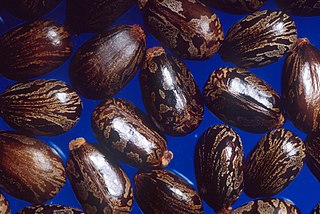Related Research Articles

Nylon is a generic designation for a family of synthetic polymers composed of polyamides. Nylon is a silk-like thermoplastic, generally made from petroleum, that can be melt-processed into fibers, films, or shapes. Nylon polymers can be mixed with a wide variety of additives to achieve many property variations. Nylon polymers have found significant commercial applications in fabric and fibers, in shapes, and in films.

Petrochemicals are the chemical products obtained from petroleum by refining. Some chemical compounds made from petroleum are also obtained from other fossil fuels, such as coal or natural gas, or renewable sources such as maize, palm fruit or sugar cane.

Castor oil is a vegetable oil pressed from castor beans. It is a colourless or pale yellow liquid with a distinct taste and odor. Its boiling point is 313 °C (595 °F) and its density is 0.961 g/cm3. It includes a mixture of triglycerides in which about 90% of fatty acids are ricinoleates. Oleic acid and linoleic acid are the other significant components.

A thermoplastic, or thermosoft plastic, is any plastic polymer material that becomes pliable or moldable at a certain elevated temperature and solidifies upon cooling.
A polyamide is a polymer with repeating units linked by amide bonds.
Polyamide-imides are either thermosetting or thermoplastic, amorphous polymers that have exceptional mechanical, thermal and chemical resistant properties. Polyamide-imides are used extensively as wire coatings in making magnet wire. They are prepared from isocyanates and TMA in N-methyl-2-pyrrolidone (NMP). A prominent distributor of polyamide-imides is Solvay Specialty Polymers, which uses the trademark Torlon.
In organic chemistry, a dicarboxylic acid is an organic compound containing two carboxyl groups. The general molecular formula for dicarboxylic acids can be written as HO2C−R−CO2H, where R can be aliphatic or aromatic. In general, dicarboxylic acids show similar chemical behavior and reactivity to monocarboxylic acids.

Polyphthalamide is a subset of thermoplastic synthetic resins in the polyamide (nylon) family defined as when 55% or more moles of the carboxylic acid portion of the repeating unit in the polymer chain is composed of a combination of terephthalic (TPA) and isophthalic (IPA) acids. The substitution of aliphatic diacids by aromatic diacids in the polymer backbone increases the melting point, glass transition temperature, chemical resistance and stiffness.
Zytel is a trademark owned by Celanese and used for a number of different high strength, abrasion and impact resistant thermoplastic polyamide formulations of the family more commonly known as nylon. The Zytel product line is based mostly on nylon 66, but also includes grades based on nylon 6 as a matrix, long chain nylons such as nylon 610, and copolymers including a transparent resin called Zytel 330. Resins based on polyphthalamides are branded 'Zytel HTN'. The Zytel product range takes advantage of the fact that nylons are one of the most compatible polymers with modifiers and so offers grades with varying degrees of fiberglass, from 13% to 60%,, rubber toughened resins, flame retarded grades. Nylon resins with mineral reinforcement are branded 'Minlon'.

Polyester is a category of polymers that contain the ester functional group in every repeat unit of their main chain. As a specific material, it most commonly refers to a type called polyethylene terephthalate (PET). Polyesters include naturally occurring chemicals, such as in plants and insects, as well as synthetics such as polybutyrate. Natural polyesters and a few synthetic ones are biodegradable, but most synthetic polyesters are not. Synthetic polyesters are used extensively in clothing.
Undecylenic acid is an organic compound with the formula CH2=CH(CH2)8CO2H. It is an unsaturated fatty acid. It is a colorless oil. Undecylenic acid is mainly used for the production of Nylon-11 and in the treatment of fungal infections of the skin, but it is also a precursor in the manufacture of many pharmaceuticals, personal hygiene products, cosmetics, and perfumes. Salts and esters of undecylenic acid are known as undecylenates.

Ricinoleic acid, formally called 12-hydroxy-9-cis-octadecenoic acid is a fatty acid. It is an unsaturated omega-9 fatty acid and a hydroxy acid. It is a major component of the seed oil obtained from castor plant seeds and is also found in the sclerotium of ergot. About 90% of the fatty acid content in castor oil is the triglyceride formed from ricinoleic acid.
Nylon 66 is a type of polyamide or nylon. It, and nylon 6, are the two most common for textile and plastic industries. Nylon 66 is made of two monomers each containing 6 carbon atoms, hexamethylenediamine and adipic acid, which give nylon 66 its name. Aside from its superior physical characteristics, nylon 66 is attractive because its precursors are inexpensive.

Methyl acrylate is an organic compound, more accurately the methyl ester of acrylic acid. It is a colourless liquid with a characteristic acrid odor. It is mainly produced to make acrylate fiber, which is used to weave synthetic carpets. It is also a reagent in the synthesis of various pharmaceutical intermediates. Owing to the tendency of methyl acrylate to polymerize, samples typically contain an inhibitor such as hydroquinone.
Arkema S.A. is a publicly listed, multi-national manufacturer of specialty materials, headquartered in Colombes, near Paris, France. It has three specialty materials segments ; adhesives, advanced materials and coatings. A further segment covers chemical intermediates.
Nylon 12 is a nylon polymer with the formula [(CH2)11C(O)NH]n. It is made from ω-aminolauric acid or laurolactam monomers that each have 12 carbons, hence the name ‘Nylon 12’. It is one of several nylon polymers.

2-Octanol is an organic compound with the chemical formula CH3CH(OH)(CH2)5CH3. It is a colorless oily liquid that is poorly soluble in water but soluble in most organic solvents. 2-Octanol is classified fatty alcohol. A secondary alcohol, it is chiral.

Nylon 46 is a high heat resistant polyamide or nylon. DSM is the only commercial supplier of this resin, which markets under the trade name Stanyl. Nylon 46 is an aliphatic polyamide formed by the polycondensation of two monomers, one containing 4 carbon atoms, 1,4-diaminobutane (putrescine), and the other 6 carbon atoms, adipic acid, which give nylon 46 its name. It has a higher melting point than nylon 6 or nylon 66 and mainly used in applications which must withstand high temperatures.
11-Aminoundecanoic acid is an organic compound with the formula H2N(CH2)10CO2H. This white solid is classified as an amine and a fatty acid. 11-Aminoundecanoic acid is a precursor to Nylon-11.
Polyesteramides are a class of synthetic polymers connected by ester and amide bonds.
References
- ↑ Herzog, Ben; Kohan, Melvin I.; Mestemacher, Steve A.; Pagilagan, Rolando U.; Redmond, Kate (2013), "Polyamides", Ullmann's Encyclopedia of Industrial Chemistry, American Cancer Society, doi:10.1002/14356007.a21_179.pub3, ISBN 9783527306732, S2CID 241272519
- 1 2 3 4 5 6 7 8 "Rilsan PA11 Brochure". Arkema. 2005. Retrieved 2018-11-28.
- ↑ Seymour, Raymond B.; Kirshenbaum, Gerald S., eds. (1987). High Performance Polymers: Their Origin and Development. doi:10.1007/978-94-011-7073-4. ISBN 978-94-011-7075-8.
- ↑ Arkema. "Arkema celebrates the 70th birthday of its flagship Rilsan® polyamide 11 brand". www.arkema-americas.com. Retrieved 2018-11-18.
- 1 2 Devaux, Jean-François. "APPLICATION OF ECO-PROFILE METHODOLOGY TO POLYAMIDE 11" (PDF). Arkema.
- 1 2 3 4 5 Selke, Susan E.M.; Culter, John D. (2015-12-11), "Major Plastics in Packaging", Plastics Packaging, Carl Hanser Verlag GmbH & Co. KG, pp. 101–157, doi:10.3139/9783446437197.004, ISBN 9783446407909
- ↑ Permeability and other film properties of plastics and elastomers. 1996-01-01.
- ↑ "Nylon Coating Services". www.wrightcoating.com. Retrieved 2018-12-02.
- ↑ Gordon., Cook, J. (1984-01-01). Handbook of textile fibres. Volume 1, Natural fibers (Fifth ed.). Cambridge, England. ISBN 9781845693152. OCLC 874158248.
{{cite book}}: CS1 maint: location missing publisher (link) CS1 maint: multiple names: authors list (link)